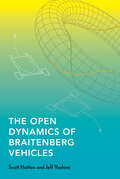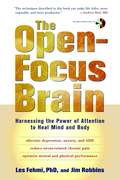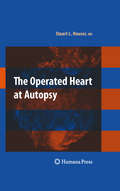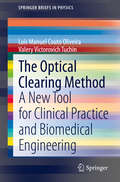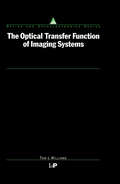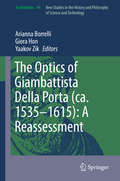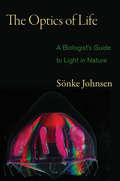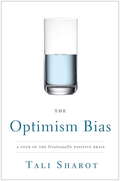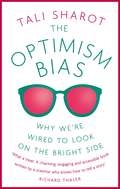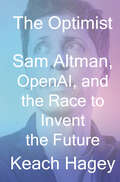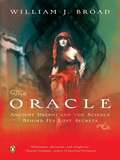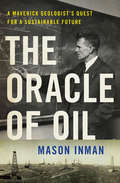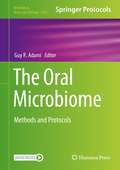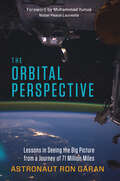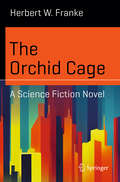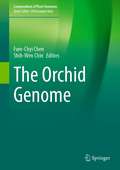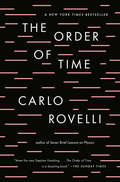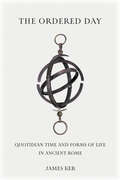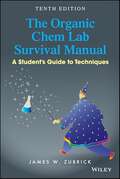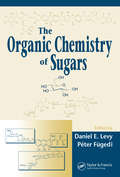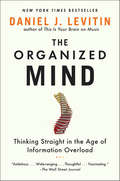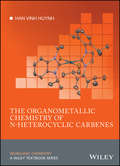- Table View
- List View
The Open Dynamics of Braitenberg Vehicles
by Jeff Yoshimi Scott HottonAn introduction to dynamical systems theory, a detailed mathematical analysis of pairs of Braitenberg vehicles, and a look at how these results apply to the study of physical and biological organisms.Powering the concept of a Braitenberg vehicle, developed in 1984 by the Italian-Austrian cyberneticist Valentino Braitenberg, is the idea that simple systems can produce complex behaviors. A pair of interacting Braitenberg vehicles is simple, but they can meander, wind around, and follow each another in a number of ways. In this book, Scott Hotton and Jeff Yoshimi show how dynamical systems theory—in particular the theory of open dynamic systems—can be used to analyze pairs of these vehicles in great detail. The result of the authors&’ long-standing collaboration at the intersection of mathematics, philosophy, cognitive science, and biology, The Open Dynamics of Braitenberg Vehicles offers a rigorous mathematical foundation for embodied cognition, especially when it comes to two-way interactions between an agent and its environment.Following an introduction to dynamical systems theory, and the most detailed mathematical analysis of Braitenberg vehicles to date, Hotton and Yoshimi discuss how their results can be applied to the study of physical and biological systems. They also describe their work's relevance to debates in the philosophy of embodied cognitive science. Combining the best features of embodied and representational approaches to cognitive science, complete with code and simulations, The Open Dynamics of Braitenberg Vehicles provides an extremely accessible and visually rich look into the workings and applications of open dynamical systems.
The Open-Focus Brain: Harnessing the Power of Attention to Heal Mind and Body
by Jim Robbins Les FehmiIn this health book, Dr. Les Fehmi a pioneering researcher and clinician teams up with Jim Robbins, an award-winning science writer, to present a disarmingly simple idea: the way we pay attention in daily life plays a critical role in our health and well-being.
The Operated Heart at Autopsy
by Stuart Lair HouserThe Operated Heart at Autopsy addresses the need of pathologists in practice and, especially, in training to achieve a new level of competence in dealing, at the time of autopsy, with the anatomic complexity of a heart that has undergone previous surgical treatment, whether that treatment occurred in the recent or remote past. Ready identification of post-operative morphologic changes in the heart will greatly increase the comfort level of the pathologist as he takes on the challenge of the operated heart. By drawing on lessons learned as a cardiac surgeon, the author offers reasonable guidelines to the pathologist facing this challenging task. Such guidelines include a methodical approach to assess multiple operative procedures on the heart. Previous surgery may include construction of coronary artery bypass grafts (CABG), replacement or repair of one or more heart valves, repair of one or more congenital heart anomalies, or some other procedure. Questions will arise at such an autopsy.
The Optical Clearing Method: A New Tool for Clinical Practice and Biomedical Engineering (SpringerBriefs in Physics)
by Luís Manuel Oliveira Valery Victorovich TuchinThis book describes the Optical Immersion Clearing method and its application to acquire information with importance for clinical practice and various fields of biomedical engineering. The method has proved to be a reliable means of increasing tissue transparency, allowing the investigator or surgeon to reach deeper tissue layers for improved imaging and laser surgery. This result is obtained by partial replacement of tissue water with an active optical clearing agent (OCA) that has a higher refractive index and is a better match for the refractive index of other tissue components. Natural tissue scattering is thereby reduced. An exponential increase in research using this method has occurred in recent years, and new applications have emerged, both in clinical practice and in some areas of biomedical engineering. Recent research has revealed that treating ex vivo tissues with solutions containing active OCAs in different concentrations produces experimental data to characterize drug delivery or to discriminate between normal and pathological tissues. The obtained drug diffusion properties are of interest for the pharmaceutical and organ preservation industry. Similar data can be estimated with particular interest for food preservation. The free water content evaluation is also of great interest since it facilitates the characterization of tissues to discriminate pathologies. An interesting new application that is presented in the book regards the creation of two optical windows in the ultraviolet spectral range through the application of the immersion method. These induced transparency windows open the possibility to diagnose and treat pathologies with ultraviolet light. This book presents photographs from the tissues we have studied and figures that represent the experimental setups used. Graphs and tables are also included to show the numerical results obtained in the sequential calculations performed.
The Optical Transfer Function of Imaging Systems (Series In Optics And Optoelectronics Ser.)
by Thomas WilliamsThe Optical Transfer Function of Imaging Systems deals extensively with the theoretical concept of the optical transfer function (OTF), its measurement, and application to imaging devices. The OTF is a mathematical entity describing how well the subject is transferred into an image via the lens.The book focuses on the practical aspects of using and measuring the OTF. It presents the background physics necessary to understand and assess the performance of the great proliferation of electro-optical systems, including image intensifiers, video cameras, and thermal imagers. Assuming a senior undergraduate level of optics knowledge, the book is suitable for graduate courses in optics, electro-optics, and photographic science. In addition, it is a practical guide for systems designers who require a means of assessing and specifying the performance of imaging systems. It is also of interest to physicists and engineers working in all areas of imaging.
The Optics of Giambattista Della Porta (ca. 1535–1615): A Reassessment
by Arianna Borrelli Giora Hon Yaakov ZikThis volume contains essays that examine the optical works of Giambattista Della Porta, an Italian natural philosopher during the Scientific Revolution. Coverage also explores the science and technology of early modern optics. Della Porta's groundbreaking book, Magia Naturalis (Natural Magic), includes a prototype of the camera. Yet, because of his obsession with magic, Della Porta's scientific achievements are often forgotten. As the contributors argue, his work inspired such great minds as Johanes Kepler and Francis Bacon. After reading this book, researchers, historians, and students will have a better appreciation of this influential scientist. They will also gain a greater understanding of an important period in the history of optics. Readers will learn about Della Porta's experimental method, a process governed by the protocols, aims, and theoretical assumptions of natural magic. Coverage also discusses the material properties and limitations of optical technology in the early 17th century, based on a recently discovered Dutch spyglass. It also demonstrates how diagrams were instrumental in the discovery of the sine law of refraction. In addition, the book includes an in-depth analysis of previously untranslated Latin sources. This makes the material useful to historians of optics unfamiliar with the language. More than 70 illustrations complement the text.
The Optics of Life
by Sonke JohnsenOptics--a field of physics focusing on the study of light--is also central to many areas of biology, including vision, ecology, botany, animal behavior, neurobiology, and molecular biology. The Optics of Life introduces the fundamentals of optics to biologists and nonphysicists, giving them the tools they need to successfully incorporate optical measurements and principles into their research. Sönke Johnsen starts with the basics, describing the properties of light and the units and geometry of measurement. He then explores how light is created and propagates and how it interacts with matter, covering topics such as absorption, scattering, fluorescence, and polarization. Johnsen also provides a tutorial on how to measure light as well as an informative discussion of quantum mechanics. The Optics of Life features a host of examples drawn from nature and everyday life, and several appendixes that offer further practical guidance for researchers. This concise book uses a minimum of equations and jargon, explaining the basic physics of light in a succinct and lively manner. It is the essential primer for working biologists and for anyone seeking an accessible introduction to optics.
The Optimism Bias
by Tali SharotFrom a leading neuroscience researcher, an exploration of the neural basis of optimism, and how the brain simulates the future. How does the brain generate hope? How does it trick us into moving forward? What happens when it fails? How do the brains of optimists differ from those of pessimists? Psychologists have long been aware that most people tend to entertain an irrationally positive outlook on their lives. Optimism may be so crucial to our existence that it is hard-wired into our brains. With the emergence of MRI brain imaging, we are beginning to understand the neural mechanisms and to understand the biological basis of optimism, and how our optimistic illusions affect our financial, professional and emotional decisions.From the Hardcover edition.
The Optimism Bias: Why we're wired to look on the bright side
by Tali SharotWinner of the British Psychological Society Book Award for Popular PsychologyPsychologists have long been aware that most people tend to maintain an irrationally positive outlook on life. In fact, optimism may be crucial to our existence. Tali Sharot's original cognitive research demonstrates in surprising ways the biological basis for optimism. In this fascinating exploration, she takes an in-depth, clarifying look at how the brain generates hope and what happens when it fails; how the brains of optimists and pessimists differ; why we are terrible at predicting what will make us happy; how anticipation and dread affect us; and how our optimistic illusions affect our financial, professional, and emotional decisions.With its cutting-edge science and its wide-ranging and accessible narrative, The Optimism Bias provides us with startling new insight into how the workings of the brain create our hopes and dreams.
The Optimist: Sam Altman, OpenAI, and the Race to Invent the Future
by Keach Hagey“The first major biography of tech’s newest titan, this sets a high bar for those to follow.”—Publishers Weekly, starred review “An exemplary blend of biography, financial technology reportage, and futurology.”—Kirkus, starred review From an acclaimed Wall Street Journal reporter comes the first biography of the enigmatic leader of the AI revolution, charting his ascent within the tech world as well as his ambitions for this powerful new technology. On November 30, 2022, OpenAI released ChatGPT, a chatbot that captivated the world with its uncanny ability to hold humanlike conversations. Not even a year later, on November 17, 2023, Sam Altman, the CEO of OpenAI, was summarily fired on a video call by the company’s board. The firing made headlines around the globe: OpenAI is the leader in the race to build AGI—artificial general intelligence, or AI that can think like a human being—and Altman is the most prominent figure in the field. Yet it was mere days before Altman was back running the company he had co-founded, with most of the directors who voted to fire him themselves removed from the board. The episode was a demonstration of how quickly the industry is moving, and of Altman’s power to bend reality to his will. In The Optimist, the Wall Street Journal reporter Keach Hagey presents the most detailed account yet of Altman’s rise, from his precocious childhood in St. Louis to his first, failed startup experience; his time as legendary entrepreneur Paul Graham’s protégé and successor as head of Y Combinator, the start-up accelerator where Altman became the premier power broker in Silicon Valley; the founding of OpenAI and his recruitment of a small yet superior team; and his struggle to keep his company at the cutting edge while fending off determined rivals, including Elon Musk, a former friend and now Altman’s bitter opponent. Hagey conducted more than 250 interviews, with Altman’s family, friends, teachers, mentors, co-founders, colleagues, investors, and portfolio companies, in addition to spending hours with Altman himself. The person who emerges in her portrait is a brilliant dealmaker with a love of risk, who believes in technological progress with an almost religious conviction—yet who sometimes moves too fast for the people around him. With both the promise and peril of AI increasing by the day, Hagey delivers a nuanced, balanced, revelatory account of the individual who is leading us into what he himself has called “the intelligence age.” Altman is a figure out of Isaac Asimov or Neal Stephenson. Or he is the author himself: if it feels as though we have all collectively stepped into a science fiction short story, it is Altman who is writing it.
The Oracle
by William J. BroadA gripping modern-day detective story about the scientific quest to understand the Oracle of Delphi Like Walking the Bible, this fascinating book turns a modern eye on an enduring legend. The Oracle of Delphi was one of the most influential figures in ancient Greece. Human mistress of the god Apollo, she had the power to enter into ecstatic communion with him and deliver his prophesies to men. Thousands of years later, Pulitzer Prize-winning journalist William J. Broad follows a crew of enterprising researchers as they sift through the evidence of history, geology, and archaeology to reveal-as far as science is able-the source of her visions. .
The Oracle of Night: The History and Science of Dreams
by Daniel Hahn Sidarta RibeiroA groundbreaking history of the human mind told through our experience of dreams—from the earliest accounts to current scientific findings—and their essential role in the formation of who we are and the world we have made. What is a dream? Why do we dream? How do our bodies and minds use them? These questions are the starting point for this unprecedented study of the role and significance of this phenomenon. An investigation on a grand scale, it encompasses literature, anthropology, religion, and science, articulating the essential place dreams occupy in human culture and how they functioned as the catalyst that compelled us to transform our earthly habitat into a human world. From the earliest cave paintings—where Sidarta Ribeiro locates a key to humankind&’s first dreams and how they contributed to our capacity to perceive past and future and our ability to conceive of the existence of souls and spirits—to today&’s cutting-edge scientific research, Ribeiro arrives at revolutionary conclusions about the role of dreams in human existence and evolution. He explores the advances that contemporary neuroscience, biochemistry, and psychology have made into the connections between sleep, dreams, and learning. He explains what dreams have taught us about the neural basis of memory and the transformation of memory in recall. And he makes clear that the earliest insight into dreams as oracular has been elucidated by contemporary research. Accessible, authoritative, and fascinating, The Oracle of Night gives us a wholly new way to understand this most basic of human experiences.
The Oracle of Oil: A Maverick Geologist's Quest for a Sustainable Future
by Mason InmanThe first comprehensive biography of Marion King Hubbert, the "father of peak oil." In 1956, geologist and Shell Oil researcher Marion King Hubbert delivered a speech that has shaped world energy debates ever since. Addressing the American Petroleum Institute, Hubbert dropped a bombshell on his audience: U.S. oil production would peak by 1970 and decline steadily thereafter. World production would follow the same fate, reaching its peak soon after the turn of the millennium. In battles stretching over decades, Hubbert defended his forecasts against opponents from both the oil industry and government. Hubbert was proved largely correct during the energy crises of the 1970s and hailed as a "prophet" and an "oracle." Even amid our twenty-first-century fracking boom, Hubbert's underlying logic holds true--while remaining a source of debate and controversy. A rich biography of the man behind peak oil, The Oracle of Oil follows Hubbert from his early days as a University of Chicago undergraduate to his first, ill-fated forays into politics in the midcentury Technocracy movement, and charts his rise as a top geologist in the oil industry and energy expert within the U.S. government. In a deeply researched narrative that mines Hubbert's papers and correspondence for the first time, award-winning journalist Mason Inman rescues the story of a man who shocked the scientific community with his eccentric brilliance. The Oracle of Oil also skillfully situates Hubbert in his era: a time of great intellectual ferment and discovery, tinged by dark undercurrents of intellectual witch hunts. Hubbert emerges as an unapologetic iconoclast who championed sustainability through his lifelong quest to wean the United States--and the wider world--off fossil fuels, as well as by questioning the pursuit of never-ending growth. In its portrait of a man whose prescient ideas still resonate today, The Oracle of Oil looks to the past to find a guiding philosophy for our future.
The Oral Microbiome: Methods and Protocols (Methods in Molecular Biology #2327)
by Guy R. AdamiThis volume discusses the oral microbiome, and oral and systemic health. The chapters in this book cover topics such as analytical techniques for identifying and measuring oral bacteria; strategies for controlling common sources of variability in oral microbiome methods for viral bacterial and fungal analysis; ways to study oral DNA and RNA samples to identify molecular pathways to disease; approaches to functional assays for oral bacteriophage, antibiotic purging of systemic bacteria; and metaproteomic analysis of various oral samples. Written in the highly successful Methods in Molecular Biology series format, chapters include introductions to their respective topics, lists of the necessary materials and reagents, step-by-step, readily reproducible laboratory protocols, and tips on troubleshooting and avoiding known pitfalls. Cutting-edge and practical, The Oral Microbiome: Methods and Protocols is a valuable resource for any scientist or researcher looking to further study this exciting and developing field.
The Orbital Perspective: Lessons in Seeing the Big Picture from a Journey of 71 Million Miles
by Ron GaranFor astronaut Ron Garan, living on the International Space Station was a powerful, transformative experience—one that he believes holds the key to solving our problems here on Earth. On space walks and through windows, Garan was struck by the stunning beauty of the Earth from space but sobered by knowing how much needed to be done to help this troubled planet. And yet on the International Space Station, Garan, a former fighter pilot, was working work side by side with Russians, who only a few years before were “the enemy.” If fifteen nationalities could collaborate on one of the most ambitious, technologically complicated undertakings in history, surely we can apply that kind of cooperation and innovation toward creating a better world. That spirit is what Garan calls the “orbital perspective.”Garan vividly conveys what it was like learning to work with a diverse group of people in an environment only a handful of human beings have ever known. But more importantly, he describes how he and others are working to apply the orbital perspective here at home, embracing new partnerships and processes to promote peace and combat hunger, thirst, poverty, and environmental destruction. This book is a call to action for each of us to care for the most important space station of all: planet Earth. You don't need to be an astronaut to have the orbital perspective. Garan's message of elevated empathy is an inspiration to all who seek a better world.
The Orca Scientists (Scientists in the Field Series)
by Andy Comins Kim Perez ValiceFollow the scientists working in the Pacific Northwest to learn about the orca whale population there, as they race to save these remarkable mammals from extinction. Perfect for fans of The Great White Shark Scientist and readers looking for excellent nonfiction on this high-interest animal. Orcas have a reputation for being bloodthirsty, but that myth is being debunked as scientists learn more about these "killer" animals. Readers follow scientists in the Pacific Northwest who study the nuanced communication patterns, family structure, and socialization of orca whales, from marine biologists to specialists in the study of sound. With stunning photography and attention to field-based detail, The Orca Scientists paints a vivid picture of the individuals who have made it their life's work to better understand orcas, as well as the whales they are helping to avoid extinction.
The Orchid Cage: A Science Fiction Novel (Science and Fiction)
by Herbert W. FrankeThis book is a new English translation of the classic science fiction story written in 1961 by Herbert W. Franke, widely held to be the most important German-language science-fiction writer. A dead city on a distant planet, two groups of people trying to explore it. Step by step, they penetrate the outer ring with its ultra-modern technology, the half-ruined medieval city center and finally the mysterious center. But is the eerie city really dead? Suddenly the factories start working again, the automatons intervene, and somewhere in the background there is still something hidden that could perhaps awaken. But is it people or machines? Herbert W. Franke leads the reader into an oppressively strange world; only after the startling resolution does it become clear what lies behind the adventures of the intruders - not a cosmic strangeness, but a threatening development that could affect humans in the same way. Franke's novel is thus a parable of the evolution of all humans in the age of technical communication ...
The Orchid Genome (Compendium of Plant Genomes)
by Fure-Chyi Chen Shih-Wen ChinThis book provides information on genome complexity and evolution, transcriptome analysis, miRNome, simple sequence repeats, genome relationships, molecular cytogenetics, polyploidy induction and application, flower and embryo development. Orchids account for a great part of the worldwide floriculture trade both as cut flowers and as potted plants and are assessed to comprise around 10% of global fresh cut flower trade. A better understanding of the basic botanical characteristics, flower regulation, molecular cytogenetics, karyotypes and DNA content of important orchids will aid in the efficient development of new cultivars. The book also describes the composition, expression and function of various microRNAs and simple sequence repeats. Information on their involvement in all aspects of plant growth and development will aid functional genomics studies.
The Order of Days: The Maya World and the Truth About 2012
by David StuartThe world's foremost expert on Maya culture looks at 2012 hysteria and explains the truth about what the Maya meant and what we want to believe.Apocalypse 2012: An Investigation into Civilizations End. The World Cataclysm in 2012. 2012: The return of Quetzalcoatl. According to many of these alarmingly titled books, the ancient Maya not only had a keen insight into the mystical workings of our planet and the cosmos, but they were also able to predict that the world will end in the year 2012.David Stuart, the foremost scholar of the Maya and recipient of numerous awards for his work, takes a hard look at the frenzy over 2012 and offers a fascination (and accurate) trip through Mayan culture and belief. Stuart shows how the idea that the "end of the Mayan calendar," which supposedly heralds the end of our own existence, says far more about our culture than about the ancient Maya. The Order of Days explores how the real intellectual achievement of ancient Maya timekeeping and worldview is far more impressive and remarkable than any of the popular, and often outrageous, claims about this advanced civilization.As someone who has studied the Maya for nearly all of his life and who specializes in reading their ancient texts, Stuart sees the 2012 hubbub as the most recent in a long chain of related ideas about Mesoamericans, the Maya in particular, that depicts them as somehow oddball, not "of this world," or as having some strong mystical link to other realms.Because the year 2012 has no prominent role in anything the ancient Maya ever actually wrote, Stuart takes a wider look at the Maya concepts of time and their underlying philosophy as we can best understand them. The ancient Maya, Stuart contends, were worthy of study and admiration not because they were strange but because they were altogether human, and they developed a compelling vision of time unlike any other civilization before or since.From the Hardcover edition.
The Order of Time
by Carlo Rovelli<P>From the bestselling author of Seven Brief Lessons on Physics, a concise, elegant exploration of time.Why do we remember the past and not the future? What does it mean for time to "flow"? <P>Do we exist in time or does time exist in us? In lyric, accessible prose, Carlo Rovelli invites us to consider questions about the nature of time that continue to puzzle physicists and philosophers alike. <P>For most readers this is unfamiliar terrain. We all experience time, but the more scientists learn about it, the more mysterious it remains. We think of it as uniform and universal, moving steadily from past to future, measured by clocks. <P>Rovelli tears down these assumptions one by one, revealing a strange universe where at the most fundamental level time disappears. He explains how the theory of quantum gravity attempts to understand and give meaning to the resulting extreme landscape of this timeless world. <P>Weaving together ideas from philosophy, science and literature, he suggests that our perception of the flow of time depends on our perspective, better understood starting from the structure of our brain and emotions than from the physical universe. <P>Already a bestseller in Italy, and written with the poetic vitality that made Seven Brief Lessons on Physics so appealing, The Order of Time offers a profoundly intelligent, culturally rich, novel appreciation of the mysteries of time. <P><b>A New York Times Bestseller</b>
The Ordered Day: Quotidian Time and Forms of Life in Ancient Rome (Cultural Histories of the Ancient World)
by James KerTraces how the day has served as a key organizing concept in Roman culture—and beyond.How did ancient Romans keep track of time? What constituted a day in ancient Rome was not the same twenty-four hours we know today. In The Ordered Day, James Ker traces how the day served as a key organizing concept, both in antiquity and in modern receptions of ancient Rome. Romans used the story of how the day emerged as a unit of sociocultural time to give order to their own civic and imperial history. Ancient literary descriptions of people's daily routines articulated distinctive forms of life within the social order. And in the imperial period and beyond, outsiders—such as early Christians in their monastic rules and modern antiquarians in books on daily life—ordered their knowledge of Roman life through reworking the day as a heuristic framework.Scholarly interest in Roman time has recently moved from the larger unit of the year and calendar to smaller units of time, especially in the study of sundials and other timekeeping technologies of the ancient Mediterranean. Through extensive analysis of ancient literary texts and material culture as well as modern daily life handbooks, Ker demonstrates the privileged role that "small time" played, and continues to play, in Roman literary and cultural history. Ker argues that the ordering of the day provided the basis for the organizing of history, society, and modern knowledge about ancient Rome. For readers curious about daily life in ancient Rome as well as for students and scholars of Roman history and Latin literature, The Ordered Day provides an accessible and fascinating account of the makings of the Roman day and its relationship to modern time structures.
The Organic Chem Lab Survival Manual: A Student's Guide to Techniques
by James W. ZubrickWritten for the laboratory that accompanies the sophomore/junior level courses in Organic Chemistry, Zubrick provides students with a valuable guide to the basic techniques of the Organic Chemistry lab. The book will help students understand and practice good lab safety. It will also help students become familiar with basic instrumentation, techniques and apparatus and help them master the latest techniques such as interpretation of infrared spectroscopy. The guide is mostly macroscale in its orientation.
The Organic Chemistry of Sugars
by Daniel E. Levy Péter FügediIntrigued as much by its complex nature as by its outsider status in traditional organic chemistry, the editors of The Organic Chemistry of Sugars compile a groundbreaking resource in carbohydrate chemistry that illustrates the ease at which sugars can be manipulated in a variety of organic reactions. Each chapter contains numerous examples demonst
The Organized Mind: Thinking Straight In The Age Of Information Overload
by Daniel J LevitinThe information age is drowning us in an unprecedented deluge of data. At the same time, we’re expected to make more—and faster—decisions about our lives than ever before. No wonder, then, that the average person reports frequently losing car keys or reading glasses, missing appointments, and feeling worn out by the effort required just to keep up. But somehow some people become quite accomplished at managing information flow. In The Organized Mind, Daniel J. Levitin, Ph.D., uses the latest brain science to demonstrate how those people excel—and how readers can use these methods to regain a sense of mastery over the way they organize their homes, workplaces, and lives. With lively, entertaining chapters on everything from the kitchen junk drawer to health care to gambling in Las Vegas, Levitin reveals how new research into the cognitive neuroscience of attention and memory can be applied to daily life. His practical suggestions call for relatively minor changes that require little effort but will have remarkable long-term benefits for mental and physical health, productivity, and creativity. This Is Your Brain on Music showed us how to better play and appreciate music through an understanding of how the brain works. The Organized Mind shows us how to navigate the churning flow of information in our daily lives with the same neuroscientific perspective.
The Organometallic Chemistry of N-heterocyclic Carbenes
by Han Vinh HuynhThe Organometallic Chemistry of N-heterocyclic Carbenes describes various aspects of N-heterocyclic Carbenes (NHCs) and their transition metal complexes at an entry level suitable for advanced undergraduate students and above. The book starts with a historical overview on the quest for carbenes and their complexes. Subsequently, unique properties, reactivities and nomenclature of the four classical NHCs derived from imidazoline, imidazole, benzimidazole and 1,2,4-triazole are elaborated. General and historically relevant synthetic aspects for NHCs, their precursors and complexes are then explained. The book continues with coverage on the preparation and characteristics of selected NHC complexes containing the most common metals in this area, i.e. Ni, Pd, Pt, Ag, Cu, Au, Ru, Rh and Ir. The book concludes with an overview and outlook on the development of various non-classical NHCs beyond the four classical types. Topics covered include: - Stabilization, dimerization and decomposition of NHCs - Stereoelectronic properties of NHCs and their evaluation - Diversity of NHCs - Isomers of NHC complexes and their identification - NMR spectroscopic signatures of NHC complexes - normal, abnormal and mesoionic NHCs The Organometallic Chemistry of N-heterocyclic Carbenes is an essential resource for all students and researchers interested in this increasingly important and popular field of research.
